Christina Strynatka & Victoria Alarcon
Health Department
We’re surrounded by packaged goods. Whether it is packaged frozen vegetables, packaged chicken or even packaged apples, you can’t escape processed food. But the question comes when you’re faced with choosing what to buy and you’re wondering what is the better choice. Is it the double chocolate chewy bar or the peanut butter Nature Valley bar?
“When I’m looking at nutrition labels, I don’t really know what to look for specifically,” said Jai Mathur, a third-year York student. “I think if you’re like me, you’ll only look at nutrition labels when you want to lose some weight, but besides that you don’t care.”

There are many who disregard nutrition labels and go on eating what they want, but according to consulting dietician Cassandra Reid, knowing what is going into your body is an important way to stay healthy.
“Packaged foods are becoming a bit too normal in our society and because of that it’s important to try to make the better choice among the few,” explained Reid.
So how do you do that?
Seeing portion sizes and daily percentage value
When looking at food, you must begin by comparing apples to apples, says Reid. The serving size at the top of the label is your reference point to finding out how many calories and nutrients are in that product.
It keeps you on track of how much you’re eating and whether you’re eating too much, explained Reid. You shouldn’t keep only portion sizes in mind, but also daily percentage value which tells you how much percentage of that nutrient you’re getting out of the daily-recommended amount.
According to mayoclinic.com, if a product has five percent or less of a nutrient, it is considered low on that nutrient, whereas if the product has 20 percent or more, then it is considered high on that nutrient. You want to look for products that have a high percentage in fibre, vitamin A and C, calcium and iron and avoid products high in saturated and trans fat, cholesterol and sodium.
Good fat, bad fat
An enemy to everyone, and the least liked of all, fat is avoided by just about every student around. Reid says the most important thing to keep in mind, however, is not the grams of fat on the label but the kind of fat in each product.
“You want to avoid saturated and trans fat in labels,” said Reid. “And the best way to do it is by going to the list of ingredients.”
The good fats you’re looking for are canola and sunflower oil, but as soon as you see hydrogenated canola oil or hydrogenated sunflower oil, it becomes a trans fat, noted Reid. What students don’t know is that hydrogenation is a process done to good fat, which makes it into a trans fat.
Along with hydrogenated oils, shortening is a semisolid fat that contains trans fat as well. In most nutrition labels it is written as vegetable shortening and can be found in baked goods such as cookies, donuts and pastries.
Sodium: the silent killer
Almost every student overlooks sodium on a nutrition label, but it’s becoming one of the biggest health concerns in Canada, with people suffering from high blood pressure and diabetes each day.
Reid compared the stuff to a hot air balloon. “If you picture a balloon that is filled with air and you try to push it into a tub of water, you just can’t do it, there’s too much pressure. When we eat a lot of sodium that same kind of pressure is being put around all of our arteries and blood vessels.”
The reason so many people ignore sodium is because it takes a long time before the effects kick in, explained Reid; however, it’s important to note sodium makes us retain water – water is weight and makes you look puffy. The recommended amount is 1500 mg each day, says eatrightontario.com.
Simply finding other ways to flavour your food besides salt will lower your sodium intake quickly and still have food tasting good.
Carbohydrates and fibre
There are three categories for carbohydrates: sugar, fibre, and starch. Fibre is one of the most important, as it helps lower blood cholesterol levels and control blood glucose. “With fibre you need 25 to 35 grams of fibre a day, so you always want to get the highest fibre choices,” said Reid.
Good choices for high-fibre foods are cereal, dried dates, corn and bread as recommended by eatrightontario.ca.
Sugar on the other hand, can be found in products naturally or artificially, but despite that, all sugars will cause blood glucose levels to rise in the body. A good rule of thumb when it comes to sugar, said Reid, is looking for dried goods where sugar equals less than half of the total amount of carbohydrates.
Company tricks
Back in October 2010, a study was prepared by the Institute of Medicine about concerns over the way food information and portion sizes were presented by companies. Ellen Wartella, the chair of the committee who undertook the study, noted there was no standard regulation for which companies are to adhere, so at the expense of the public’s health, they are allowed to set their own guidelines and have a long leash when it comes marketing their products.
Some companies use large lettering and bright colouring to highlight their most beneficial ingredients, whereas the not-so-good ingredients are harder to find on the package. The slogans on cookies and biscuits that read “fat free” or “100 calories” are another way companies sell more products.
“Yes, a product may say it’s fat free, but that doesn’t mean it’s not filled with other kinds of junk. There might be so many calories and sodium in it that make it a poor choice,” said Reid.
Making the best choice
Packaged food has become the new trend in eating habits, says Reid, and the reality is it’s not very healthy.
“When you’re choosing a packaged good, you’re not choosing the best option. You’re choosing the better option out of the few because obviously we’d prefer it if you made things from fresh,” said Reid. An unhealthy granola bar can easily be exchanged for a peanut butter sandwich and a banana for the same amount of calories, reasoned Reid. Similarly, French fries for lunch can become a baked potato with one teaspoon of fat-free soft margarine. It’s the attitude you go about in deciding what you’re going to eat that day and though it is more convenient sometimes it’s just not healthy.
“It’s more convenient to eat packaged foods, but is it more convenient for you to have diabetes and be on dialysis when you’re in retirement? Because that’s where it will take you,” said Reid. “By spending just five to 10 minutes making some meal plans and making some healthier choices more often you’re living a healthier lifestyle.”
Fun Spaghetti

Ingredients
8 oz of whole wheat spaghetti
1 can of spaghetti sauce
1 red pepper, sliced
6 oz small black olives, sliced
4 large white mushrooms, sliced
1/2 clove of garlic, crushed
Parmesan cheese
Directions
In a pot of boiling water, add the spaghetti, broken into thirds. While the spaghetti is cooking, in a different pot pour the spaghetti sauce and wait for it to start bubbling before adding the red pepper, half-clove of garlic, mushrooms and olives. Let everything in the sauce cook for 10 minutes before turning the stove off. Drain the spaghetti from the pot once it is soft. Add the sauce to the spaghetti; serve with Parmesan cheese if desired.
A guide to reading nutrition labels


